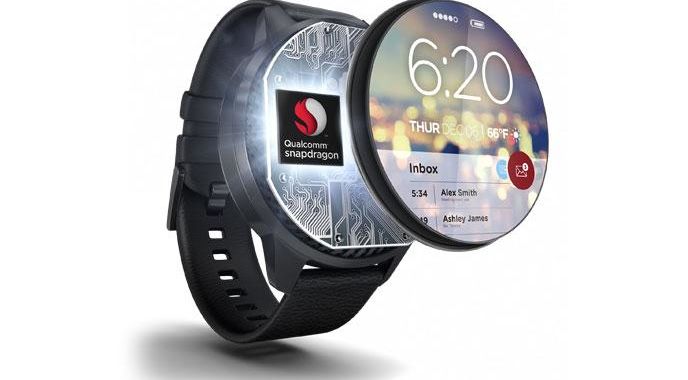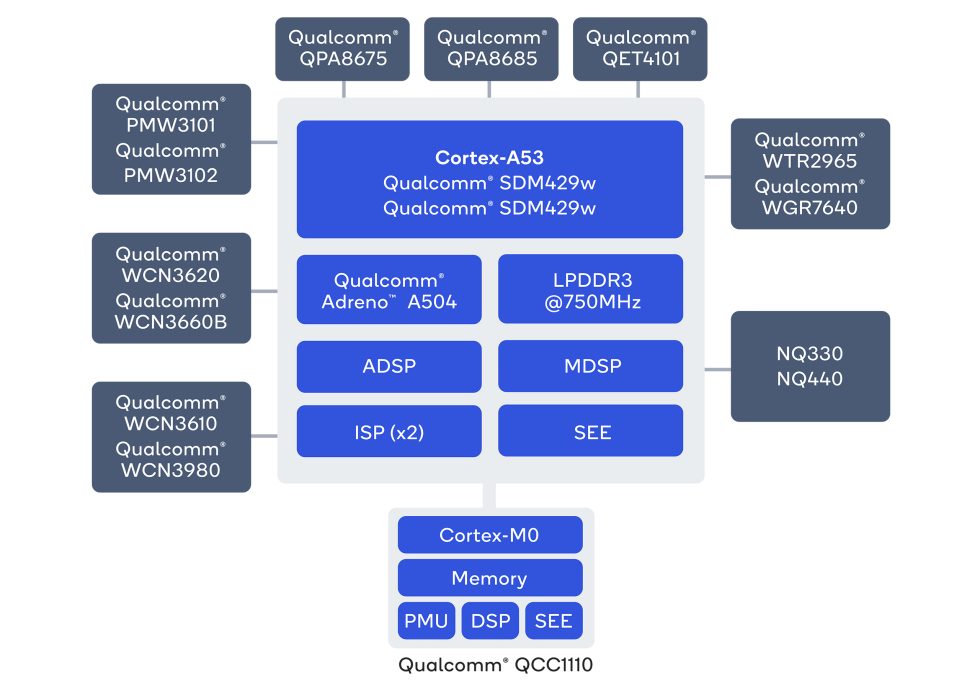

After years of repackaging the same basic smartwatch chip over and over again, Qualcomm has honored Wear OS with a modern smartwatch SoC. Get to know the Snapdragon Wear 4100, a Qualcomm smartwatch chip that, for the first time, is faster than the previous chip.
The Wear 4100 uses four 1.7GHz Cortex A53 CPUs built in a 12nm manufacturing process, a major upgrade to the 28nm Cortex A7 that all other Qualcomm smartwatch chips have been up to now. It’s not the next-gen 7nm process that uses Qualcomm’s high-end chip, and the Cortex A53 is an older CPU design, but for Qualcomm, it’s a major upgrade. Between the new CPU, Adreno 504 GPU and faster memory, Qualcomm promises “85% faster performance” compared to the Wear 3100.
Actually, there are two versions of the 4100, the Vanilla “4100” and the “4100+”. The plus version is specifically for smart watches with an always-on watch face, and like previous Wear SoCs, it comes with an extra low-power SoC (based on a Cortex-M0) to keep time updated and record data of the sensor (such as the step count) Qualcomm promises a better screen image quality in this low power mode, with more colors and a smoother screen.

Qualcomm
There are also dual DSPs now, which Qualcomm says are for “optimal workload partitions, support for dynamic clock and voltage scaling, Qualcomm Sensor-Assisted Positioning PDR Wearable 2.0, low-power location tracking support, and an architecture Bluetooth 5.0 enhanced. ” There are also dual ISPs with support for 16MP sensors (in a smart watch?). As usual, connectivity options are plentiful, with built-in LTE, GPS, NFC, Wi-Fi 802.11n, and Bluetooth 5.
Can Wear OS resurrect? (No, probably not)
Qualcomm has been neglecting the smartwatch market for years, and while Wear OS has many of its own issues, the current unfortunate state of Android smartwatches is largely Qualcomm’s fault.
Not that Qualcomm hasn’t released any smartwatch chips; the company has only been investing the least amount of resources possible by selling the same basic chip for six years. In 2014, the first Wear OS smart watches (then called Android Wear) came out with a Snapdragon 400 SoC, which used four Cortex A7 CPUs and was based on a 28nm process. In 2016 Qualcomm released the “Snapdragon Wear 2100”, but it was not much different from the previous chip, using four Cortex A7 CPUs and a 28nm process. In 2018 Qualcomm recycled the same basic design again, launching the “Snapdragon Wear 3100”, using four Cortex A7 CPUs and a 28nm manufacturing process. Qualcomm could point out additional little features available in each release, but fundamentals like CPU speed and power usage haven’t improved for six years.
After sitting still for six years, is there any Wear OS left? Lack of viable hardware has devastated the ecosystem. Many hardware manufacturers, such as Samsung, Huawei, and Asus, have moved away from the platform. Wear OS’s market share is single-digit or approaching and is so low that it is no longer mentioned separately in market share reports. Without hardware sales, developers cannot justify creating applications.
As for Google, the company appears to have slowed down the development of Wear OS. During the first years of his life, (Android) Wear OS closely followed the major Android version, but an Android 10 update never came. The last major update was for Android 9 (which Wear OS calls the “H” system version. “) in 2018. Recently, Google has made a few acquisitions supporting Wear OS that we haven’t seen the results for yet. In early 2019, he acquired unknown technology and an R&D team from Fossil Group, the largest OEM of Wear OS, for $ 40 million. In late 2019, Google bought Fitbit, a pioneer of fitness tracking devices, for $ 2.1 billion. Fitbit was not involved in Wear OS, but Google called the purchase “an opportunity to further invest in Wear OS, as well as to introduce wearable devices made by Google to the market.” The deal, Google’s fifth largest, is still making its way through regulatory approval.
It is not clear that there is an ecosystem left to buy the new Qualcomm chip. The company generally tries to promote the manufacturers it has lined up for these chip releases, but was unable to quote or verify the name of a single major OEM in its press release. The launch partner of the Wear 4100 is a company called “imoo”, the so-called “leading brand for children’s smart watches”. The company says its next-generation “Z6 Ultra smartwatch” will launch in the next 30 days with Qualcomm’s new chip.